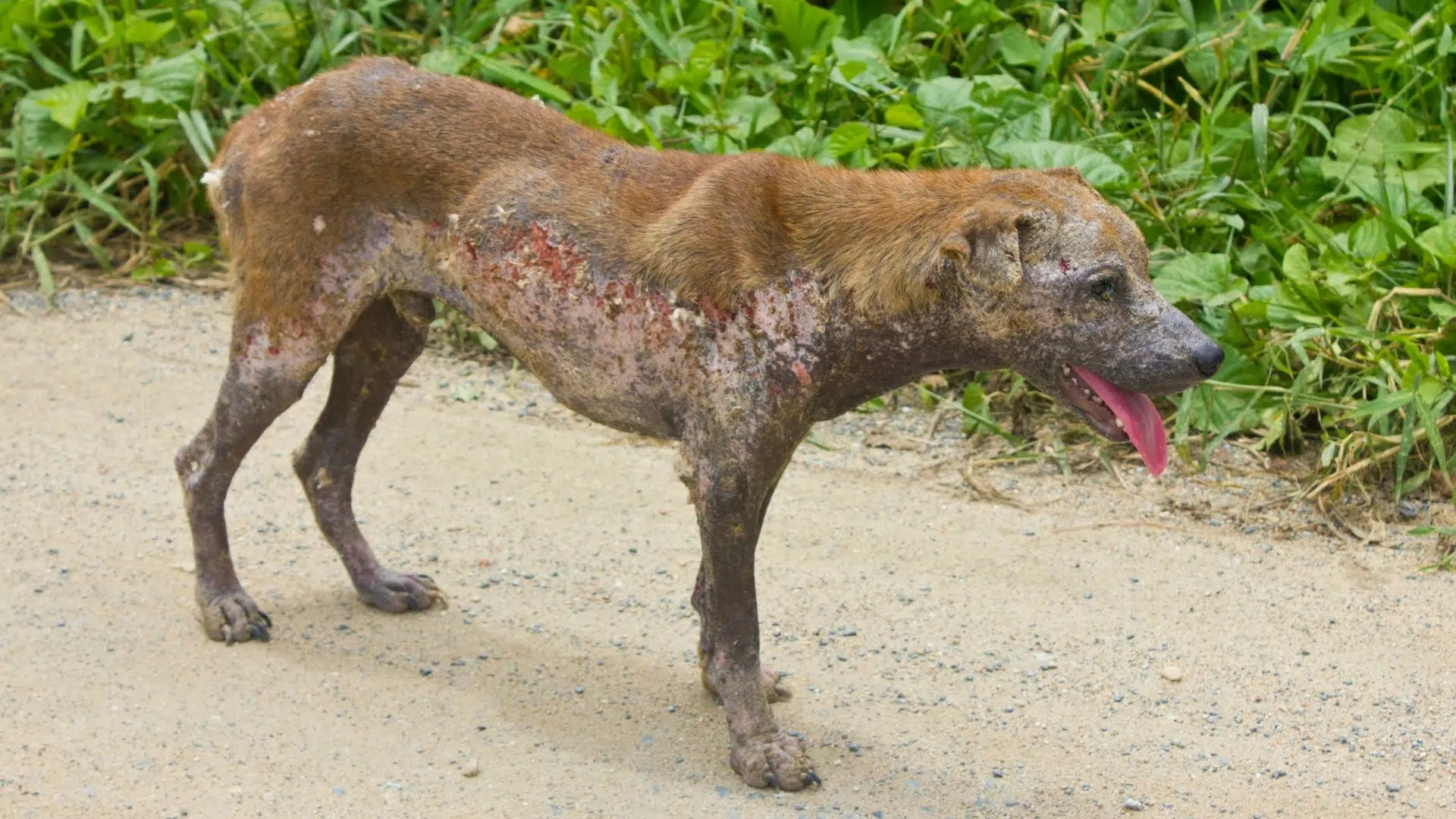

Mange mites are commonly seen in puppies and dogs who are strays. These mites will burry into your dog’s hair follicles causing your dog to itch and lose hair. There are two main types of mange that dogs can get. These are:
Demodex is inherited from their mother and passed when your puppy is drinking milk. Sarcoptic mange is very contagious and usually acquired from other animals. Both of these types of mange will have the same symptoms
Common signs and symptoms of mange in dogs:
If you notice any of these signs, it would be best to see your vet. They can determine if your dog does have mange or if there is something else causing your dog to have these symptoms.
Mange is caused by microscopic mites that are buried in your dog’s skin. These mites will lay eggs into these follicles and the next round of mites will be born. This cycle can take 2 to 3 weeks so you will have to treat your dog for at least 2 months to fully rid them of these parasites.
Mange mites are microscopic. Demodex mange is a cigar-shaped mite while sarcoptic mites are more round-shaped. These mites cannot be seen with the naked eye and you will need a microscope to find them. If your vet thinks that your dog has mange mites, they will perform a skin scrape.
Is your pet safe?
1 in 3 pets will need emergency veterinary treatment each year and it is estimated a pet receives emergency care every 2.5 seconds in the U.S.
The average cost of treating a broken bone in dogs is $2,700. Cancer treatments? Up to $10,000.
It’s why so many pet owners say their biggest regret isn’t the vet bill—it’s not having pet insurance when they needed it most.
Ask yourself: “If an unexpected $5,000 vet bill hit tomorrow, could I afford it?”
If the answer is no, it’s time to get covered.
Take a look at Lemonade. They have a great app that actually works, they have an instant chatbot that is faster and, dare we say it, friendlier than most companies’ “real” customer service and a quick scroll through Reddit will uncover… people are really vibing with this brand.
So go check them out and take a look. It takes less than a minute.
This is where they will scrape your dog’s skin with a dull blade to get some of the mites from the follicles. They can put this scraping on a slide and look for the mites under the microscope. If your dog does have mites, make sure to ask your vet if you can also see the mites.
There are a few different ways that your vet may want to treat manage. These are some of the most common treatments.
NexGuard and Bravecto are two commonly used flea and tick medications. These medications can also be used to treat mange. These medications will be given every 2 weeks for about 4 treatments will effectively kill mange mites.

This is a cattle dewormer that will also help treat mange mites. This was commonly used before Nexguard and Bravecto were developed. While Ivermectin is very effective and very inexpensive, it can cause side effects in dogs. Dogs from the hearing group such as collies cannot have ivermectin due to a mutation in the MDR1 gene. This can cause severe neurological signs in these dogs.
This is a topical flea and tick medication that can help treat mange. This medication is a derivative of ivermectin and works great at treating mange mites.
Many dips for mites are not commonly used due to their horrible smell. These dips are usually lime sulfur and your dog will need to be dipped very often. Inbetween the dips they cannot have a bath and you are left with smelling the sulfur smell on your dog.
Ensuring your dog’s skin and coat are healthy is crucial for their overall well-being. Explore top-rated supplements crafted to promote a lustrous and vibrant coat. Omega-3 fatty acids, commonly found in fish oil supplements, contribute to skin health and a shiny coat. Biotin and other essential vitamins and minerals also play a role in maintaining a healthy skin barrier.
If your dog has hair loss and is itching, it would be best for your vet to check them for mange. Your vet can take a skin scraping and look at this under the microscope to see if your dog does have mange. Your vet will be able to prescribe the appropriate treatments for your dog to help them get rid of these mange mites.
Yes, you can catch sarcoptic mange from your dog. This is a zoonotic disease meaning that it can be passed from animals to people. This will also cause a rash and extreme itching if you catch this type of mange. You will need to see your doctor for medication to clear the mange on your skin. If your dog does have scabies mange, it would be best to wash your hands and wear gloves when handling them until your dog is fully healed.
Mange mites can cause your dog to be very itchy and lose hair. If you notice any hair loss in your dog, especially if they are a puppy or recently acquired from a shelter, have your vet examine them. They can quickly perform a skin scrape to look for mites. If there are mites, there are many different treatment options depending on the breed of the dog and your vet’s recommendation. With proper treatment, your dog can easily get rid of these mites and their skin will return to normal.
Most of us train our dogs when they are puppies to jump up on furniture. We think it’s harmless (and easier than always lifting them), but for dogs, couches and beds are very high compared to the size of their bodies.
Every time they jump it compresses their back and applies enormous force to their joints.
It’s no wonder that an incredible 80% of dogs experience arthritis or joint pain by only 7 years old.
Luckily, there is a vet-recommended solution.
It’s the PawRamp by Alpha Paw. An adjustable ramp that allows dogs to safely get on and off couches and beds. PawRamp makes joining you in bed or on the couch effortless and fun.
As a bonus, you can use code SAVE35 to get $35 off the PawRamp today.

The medical, nutritional, or behavioral advice we provide is intended for informational and educational purposes only. Our editorial content is not a substitute for formal or personalized medical advice from a veterinary professional. Only board-certified veterinary specialists who have examined your pet should diagnose medical conditions, provide personalized treatment, or prescribe appropriate medication. For questions regarding your pet’s health, or if your pet is exhibiting signs of illness, injury, or distress, contact your veterinarian immediately. Never disregard professional medical advice or delay in seeking it because of something you have read on our site.